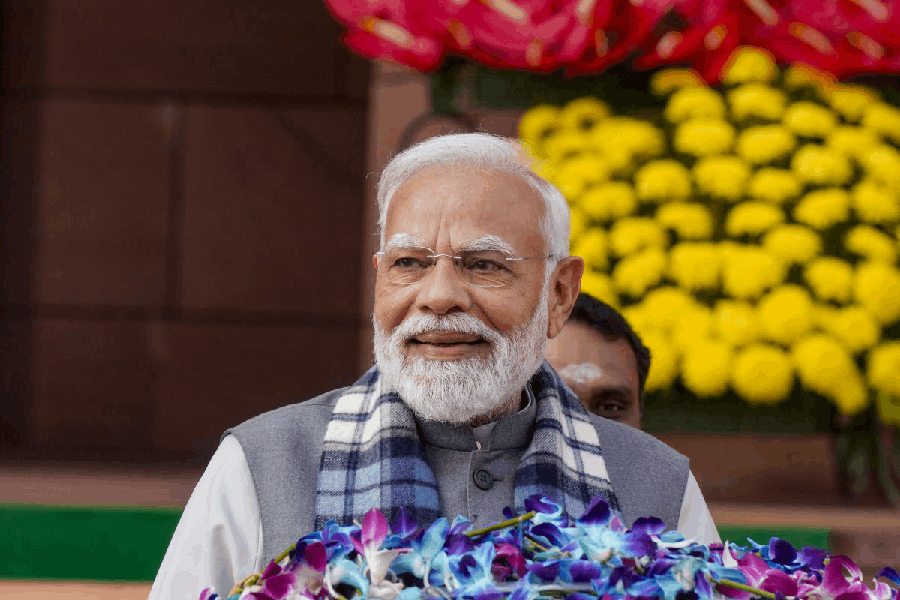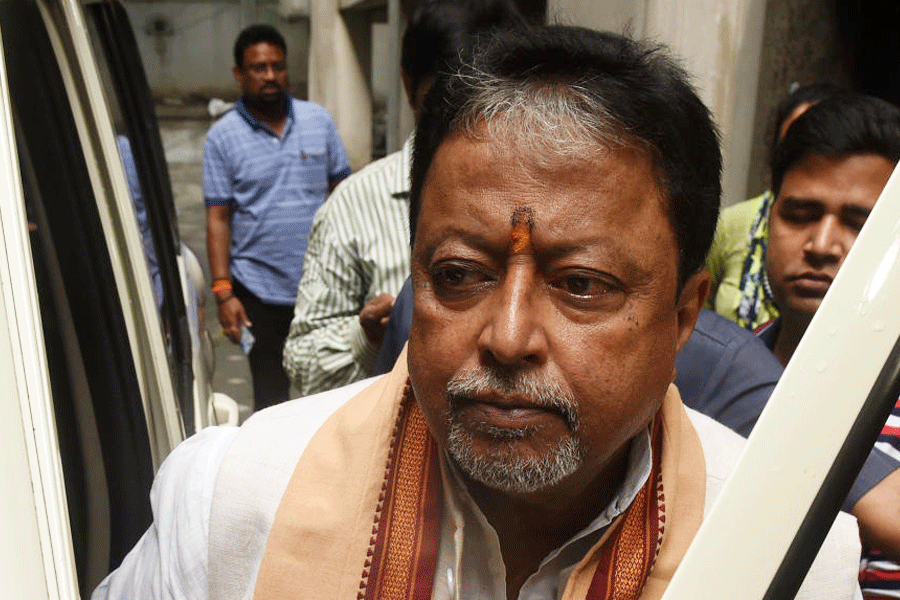 |
| Mustard and paddy crops have come up on the mounds where once houses stood. Picture by Ashok Sinha |
Baghaura-Dalelchak, Nov. 18: The tinderbox village that saw the first spark lit in a genocidal war 23 years ago was starving this afternoon for want of a matchbox to light the ovens.
All two of the ovens, that is.
For, two families are all that is left in Baghaura-Dalelchak, scene of the first massacre in Bihar’s long feud between the Maoists and the Ranvir Sena, a private army of landlords, that raged for over a decade and cost hundreds of lives.
That bloodbath of May 29, 1987, when the Maoist Communist Centre slaughtered 54 Rajputs here — and the fiery reprisal by the upper castes the next morning — turned this hamlet into a ghost village. Baghaura-Dalelchak had been emptied out long before “ethnic cleansing” became an international dirty word during the Bosnia war.
Save for the 30 people — 15 adults and 15 children — who now live in the village, 160km from Patna.
One of them, Sheela Devi, 34, was desperately hoping this afternoon that her husband would remember to buy a matchbox at Madanpur, the town 7km away where he works as a labourer, before he left for home in the evening.
Else, there would be no dinner, and no lunch tomorrow, for them or their four young children. Even her neighbour Kulwatiya Devi, 60, had run out of matches and was waiting for her two sons to return from Madanpur with a matchbox.
With just two families, this village in southern Aurangabad district has no shops to buy matches or anything else from. “We have to walk 5km to Purnadih village to buy a matchbox, and 7km to Madanpur to buy kerosene,” Sheela said.
Till May 1987, Baghaura-Dalelchak was home to over 200 people: Rajputs, Yadavs, Kumhars (potters), Pasis (toddy tappers) and Ravidases (cobblers). The day the Maoists shot and hacked to death almost all the Rajputs present — from an 80-year-old woman to an 18-month-old baby — all the others fled their homes.
The next morning, the village did not lack for matchsticks or kerosene. The angry relatives and friends of the slain came invading, kerosene containers in hand, and burnt all the non-Rajput homes.
That kicked off the chain of carnage and counter-carnage that ravaged Bihar’s Gaya-Aurangabad-Jehanabad region for over a decade, the rebels targeting the upper castes and the landlords the lower castes. The war claimed 368 lives in the ’90s, including the infamous Laxmanpur-Bathe massacre of 58 Dalits in 1997.
Now the bloodshed has ebbed.
The Maoist Communist Centre is gone six years ---- it has merged with the People’s War Group to form the CPI (Maoist). But those who fled Baghaura-Dalelchak never returned, and only the few who had nowhere to go have stayed on.
Since dropping off the headlines, the village lay forgotten through the rule of Satyendra Narayan Sinha, Jagannath Mishra, Lalu Prasad-Rabri Devi and Nitish Kumar. It now lies ignored amid the elections. No party or candidate has turned up even two days before the constituency, Rafiganj, votes on November 20.
“Why would politicians visit a village of only 15 voters?” said one of the eight women residents.
“How can they come, our village has no roads,” Sheela said.
Once you have left Madanpur and reached the end of the mud track, on which you can drive only in the dry season anyway, Baghaura-Dalelchak is a half-kilometre trek through a pagdandi ---- an uneven footpath overgrown with thorny shrubs.
The village has no electricity, no school and no hospital at a time development is the buzzword under Nitish Kumar’s rule.
Sheela, who is from the toddy tapper caste, was married to Joginder Choudhary 14 years ago. “When I learnt I was going to have to live in Baghaura-Dalelchak, a shudder ran through me because of what I had heard about the village,” she said.
Her sister-in-law Renu Devi, 27, looked petrified at the sight of The Telegraph team and hurried into one of the three mud houses where the two families live. No amount of cajoling could persuade her to come out or speak.
“We fear the sight of outsiders. Nobody ever visits us,” explained Kulwatiya. Among the last visitors were the killers and the arsonists.
The Rajputs now live in Aurangabad town or elsewhere. The Yadavs and Kumhars have mostly settled in neighbouring Laltenganj village.
Not that Laltenganj or adjacent Jurahi are any better off except in the matter of population. The entire area is under the sway of the Maoists, who have ensured that the “liberated zone” stays devoid of proper roads, electricity, schools and hospitals or any other “symbols of the state”.
The rebels, who live in the nearby hills and forests, have blocked the water of the local Koel canal at the source, said Sitaram Ravidas (name changed) at Jurahi. “If the canal were functioning, officials would come to monitor it,” he said.
“After sunset the rebels, armed with rifles and wearing olive green uniforms, move about freely. They describe themselves as our protectors but we hardly have anything they can protect for us.”
When this correspondent reached Baghaura-Dalelchak, all the seven male residents were out on work at Madanpur or Aurangabad. The only man present was Kuleshwar Ravidas, 60, from Laltenganj who had come to inspect the mustard and paddy crops he has been growing on the abandoned farms as a bataidar (share-cropper).
By arrangement with some of the landowning families that have left the village, Kuleshwar grows crops on their land ---- or on the mounds that have grown over the rubble of their homes ---- and shares the produce with them. The families of Sheela and Kulwatiya (who is from the Ravidas caste) never had any land: the women now work on Kuleshwar’s fields.
At a short distance stands the crumbling brick house of Vinay Singh and Muneshwar Singh, like a tombstone. The well in the front yard is still intact but all the house’s 10 occupants were slaughtered that day in 1987. The rusted locks still hang from the doors and the compound is overrun with weeds and bushes.
A plaque on the door shows the names of the dead, with 80-year-old Sona Kunwar’s on top and one-and-a-half-month-old Chhotu’s at the bottom. You have to strain your eyes to read the names. After a few years, perhaps, even the dead and their memories will disappear from Baghaura-Dalelchak.










